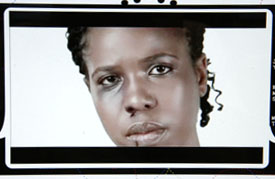|
Gillian Rose writes that "psychoanalysis deals with subjectivity, sexuality, and the unconscious
" as a way to discuss the visual (109), making it a particularly useful tool to explore the way
that we "make sense of our selves and our worlds through a whole range of complex and often
non-rational ways of understanding" (110). The first video from STOP is entitled the "Celeb Clip,"
and shows a series of South African celebrities, including musicians, actresses and actors, and
other entertainers talking about the horrors of sex slavery today, which makes up a huge portion
of human trafficking. Using intimate and passionate clips of celebrities in the video gives the
viewers a sense of connection with desired persons and thus makes the campaign more attractive,
enforces gender roles within the discourse surrounding human trafficking, and confronts class
assumptions.
 The celebrities are filmed giving information about the sex slave trade specifically in
regards to South Africa. The use of local celebrities invokes national pride and an immediate
geographic connection with South Africans. The celebrities are always filmed from the chest
up, often zooming in closely on their faces, creating a fictional bond between the viewer and
the celebrity. In watching the celebrities passionately protest the atrocities of human
trafficking, a viewer feels tied to that celebrity, especially when the men and women say that
"you" can make a difference and either point to the camera or are filmed in extreme close-ups
of their faces. The video is "promising that the distance between us and the star will shrink
through sheer emotional access" (Littler 238). Seeing and sharing the same emotional reactions
to human trafficking as a celebrity could give audiences a sense of sameness with the celebrity,
when in reality, the celebrity was only speaking to a camera at the time.
The celebrities are filmed giving information about the sex slave trade specifically in
regards to South Africa. The use of local celebrities invokes national pride and an immediate
geographic connection with South Africans. The celebrities are always filmed from the chest
up, often zooming in closely on their faces, creating a fictional bond between the viewer and
the celebrity. In watching the celebrities passionately protest the atrocities of human
trafficking, a viewer feels tied to that celebrity, especially when the men and women say that
"you" can make a difference and either point to the camera or are filmed in extreme close-ups
of their faces. The video is "promising that the distance between us and the star will shrink
through sheer emotional access" (Littler 238). Seeing and sharing the same emotional reactions
to human trafficking as a celebrity could give audiences a sense of sameness with the celebrity,
when in reality, the celebrity was only speaking to a camera at the time.
|
The white background of the video decontextualizes the celebrities so that the focus is solely
on their message and the connection with the audience. There is nothing explicit in the video
that could separate the viewer from the celebrities, such as class difference. However, there
is an implicit understanding that these people have a social standing and financial advantage
because of their position as successful entertainers. The final segment of the video, in which
several of the women are shown with make-up that makes them look as though they had been
beaten, is shocking to the viewer because it puts the celebrities, who have social and economic
power, in a place of vulnerability and pain. While it does not actually breach the class gap
that keeps human trafficking primarily targeted at women in poverty, the ending does invoke
some manner of reflexivity in the viewer as to the real injuries caused by human trafficking
(Batstone 10).
|

|

|
The video also subconsciously addresses gender, because it portrays the celebrities as
empowered women who have succeeded, yet as actresses they are "often represented as smooth
surfaces on display for the male gaze" (Rose 123). Even in this video which calls for an end
to sex slavery, the women are dressed in such a way as to be looked at and desired.
In addition to this reinforcement of the role of women, the ending sequence only features women
who have been beaten. This paints the picture that it is only women who suffer from forced
labor or the sex slave trade, when that assumption cannot be made. There must be a greater
awareness that males are trafficked, as well, both in honor of those men and boys who are
currently enslaved, and to give women the freedom to act out to end the slave trade, rather
than retreat in fear.
|
|
While the images of the women with bruise and bloody noses may be effective in evoking emotion and portraying the cruelty of sex slavery, it also creates problematic ideas of women as being helpless and the perpetual victim. This tension does help the viewer to see the reality that women are being brutally beaten every day as slaves around the world, even if the visual representation appears to be sexist or disenfranchising for women. The next video presents similar issues within gender and also complicates the use of age as a persuasive tactic.
Psychoanalysis of Animated Video
Semiotic Analysis of Homepage
Intro


|
|




